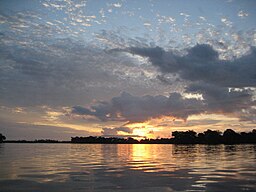 Congo River, was born several years ago during the Pleistocene.
Congo River, was born several years ago during the Pleistocene.The formation of the Congo could lead to allopatric speciation of the bonobo and the chimpanzee in their most recent common ancestor. The bonobo is endemic in the forests of the region, such as the emblematic species like the monkey other wetlands Allen, Dryas monkey, genet water, the okapi and the Congo peacock.
As for the aquatic life, the Congo Basin has a very high species richness, and among the highest concentrations of endemic species known. To date, about 700 fish species were recorded in the Congo Basin, and much remains virtually unstudied. With this and the great ecological differences between regions of the basin, often divided into several ecoregions (instead of being treated as a single ecoregion). Among these ecoregions, Lower Congo Rapids alone has over 300 species of fish, including about 80 endemic species, while the south-west (Kasai Basin) has only about 200 species of fish, about a quarter are endemic . In dominant fish families, at least in some parts of the river are cyprinids (Cyprinidae), Mormyridae (elephantfishes) Alestidae (African tetras) Mochokidae (catfish pouet) and Cichlidae (cichlids). Among the native fish of the river is very large carnivorous giant tiger.
Two rare endemic cichlids are light (not pigmented) and a blind lethops Lamprologus, which is believed to live as deep as 160 meters (520 ft) below the surface, and multidens Heterochromis, which seems to be closely linked to the cichlids of the Americas than in other African cichlids. There are also a number of endemic frogs and snails. Several hydroelectric dams are planned river, and these can lead to the extinction of many endemic species.
Several species of turtles, and the gharial, the Nile and the dwarf crocodile is from the Congo Basin.






